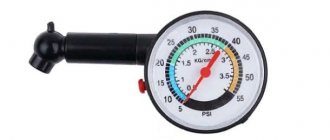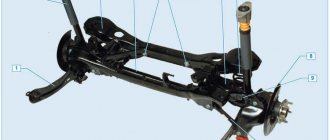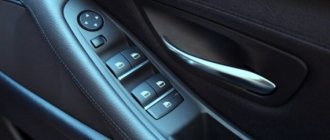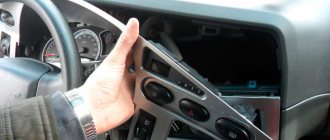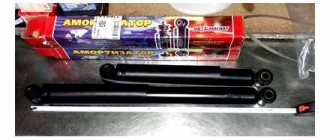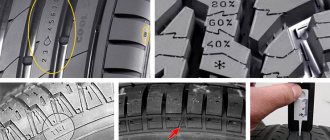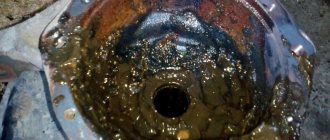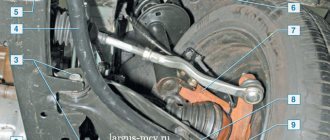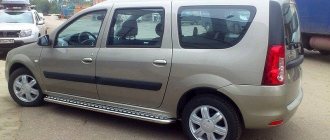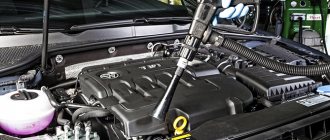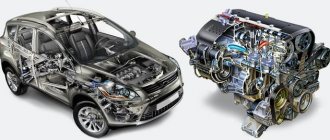How many parts does a car consist of?
Usually we rarely think about how this or that thing works.
Especially one that is a technically complex device. For example, a car. Of course, many car owners are well aware of the internal structure of the car and the operation of its components, both individually and as a whole. But have you ever wondered how many parts a modern passenger car consists of? After all, perhaps this is the most complex device that any person can own at will.
An attempt to independently count the parts in a car is doomed to failure. It is, of course, possible to do this, but then you will have to disassemble the car down to the screw.
As a rule, when repairing cars, we replace one or another entire unit, “assembled”. Meanwhile, even one shock absorber strut contains several dozen parts. Or, let's say, a piston - yes, it is a separate part, but each piston ring is also a separate part that must be taken into account.
Even car factories don't always know how many parts are used in their cars. The production of a modern car implies the presence of a huge number of subcontractors who supply the plant with ready-made components. After all, no factory assembles a multimedia system from a printed circuit board and a bunch of radio elements.
If we consider a car at the level of individual components, then it consists of approximately 1500-2000 parts. Meanwhile, even one engine includes several thousand parts (up to 5000).
But Toyota specialists did the impossible and still calculated the number of parts into which an average car can be disassembled, what is called “down to the screw”, that is, to the point where each part is no longer disassembled. The resulting figure is impressive. The number of parts is estimated at 30,000. It is clear that this figure will differ from model to model, but the order itself speaks for itself.
Thus, a car is a highly complex device that operates in difficult conditions with enormous reliability. After all, each of the parts ensures the smooth operation of the car for many years. Just imagine how reliable the design must be to ensure at least a three-year warranty without repair. One can only endlessly admire the engineering thought that has stepped far forward since the more than century-long history of the automobile.
Source
Device
Despite the variety of layouts, the car body has common elements. They are shown in the figure below and include:
- Front and rear side members. They are rectangular beams that provide structural rigidity and vibration damping.
- Front shield. Separates the engine compartment from the passenger compartment.
- Front pillars. They also provide rigidity and secure the roof.
- Roof.
- Rear pillar.
- Rear wing.
- Luggage panel.
- Middle post. Provides body rigidity and is made of durable sheet steel.
- Thresholds.
- The central tunnel where various elements are located (exhaust pipe, driveshaft, etc.). Also increases rigidity.
- Base or bottom.
- Wheel niche.
Detailed structure of the car body
The design may be different depending on the type of body (sedan, station wagon, minibus, etc.). Particular attention in the design is paid to load-bearing elements such as spars and struts.
Car from A to Z: internal combustion engine design
New section, get ready! There will be a lot of educational text with pictures.
The internal combustion engine (ICE) is the heart of the car. The main feature of these engines is that fuel ignition occurs inside the combustion chamber (CC), and not in third-party external units.
During operation, the thermal energy released as a result of fuel combustion is converted into mechanical energy.
By fuel used
- light liquid (gas, gasoline)
— heavy liquid (diesel fuel)
— Gasoline engines
There are two types: gasoline carburetor and gasoline injection.
In the first case, mixture formation (mixing fuel with air) occurs in the carburetor or in the intake manifold using injectors. Next, the mixture enters the cylinder, is compressed and ignited by a spark from a candle.
In the second case, fuel is injected into the intake manifold or into the cylinder using injectors (atomizing nozzles).
— Diesel engines
Special diesel fuel (DF) is supplied at a certain moment (before reaching dead spots) into the cylinder under high pressure using an injector.
The movement of the piston compresses the mixture even more, the fuel heats up, followed by ignition of the combustible mixture (due to high pressure).
Such engines are characterized by low speed and high torque.
— Gas engines
The engine uses hydrocarbons as fuel. Basically, such engines run on propane, but other gases are also used as fuel.
The main difference from other engines is the high compression ratio. Such engines wear out less due to the fact that the fuel is already supplied in a gaseous state. Also, the efficiency of gas engines is obvious - gas is cheaper than gasoline.
It is also worth noting that it is environmentally friendly - there is no engine smoke.
By ignition method
- from spark (petrol)
- from compression (diesel)
By number and arrangement of cylinders
— In-line engine
The most common arrangement, the cylinders are arranged in a single row perpendicular to the crankshaft. Such engines are simple in design, but with a large number of cylinders, the size of the engine increases in length.
— V-shaped
To reduce the length of the unit, the cylinders are positioned at an angle from 60 to 120 degrees, while the longitudinal axes of the cylinders coincide with the longitudinal axis of the crankshaft.
The engine turns out to be quite small longitudinally (short).
Of the minuses: the engines are quite wide and the block heads are separate, which leads to an increase in manufacturing costs.
— Opposite
The horizontally opposed engine has smaller height dimensions, which will lower the center of gravity of the entire vehicle. The advantages include: compactness, symmetrical layout.
— VR-shaped
Due to the 6 cylinders located at an angle of 150 degrees, a very compact (narrow and short) engine is formed. And also, this engine has only one cylinder head.
— W-shaped
These engines combine two rows of cylinders in a VR design.
The angle of the cylinders is 150 degrees, and the rows themselves are at an angle of 720 degrees.
A standard car engine consists of 2 mechanisms and 5 systems.
Rigidity
Rigidity is the property of a car body to resist dynamic and static loads during operation. It directly affects handling.
The higher the stiffness, the better the car's handling.
Rigidity depends on the body type, overall geometry, number of doors, car size and windows. The fastening and position of the windshield and rear windows also plays an important role. They can increase stiffness by 20-40%. To further increase rigidity, various reinforcement struts are installed.
Hatchbacks, coupes and sedans are considered the most stable. Typically, this is a three-volume layout that has additional partitions between the luggage compartment and the engine. Insufficient rigidity is shown by station wagon, passenger, and minibus bodies.
There are two stiffness parameters - bending and torsion. For torsion, resistance is checked under pressure at opposite points relative to its longitudinal axis, for example, when hanging diagonally. As already mentioned, modern cars have a solid monocoque body. In such structures, rigidity is provided mainly by side members, transverse and longitudinal beams.
Cylinder block
It is a one-piece cast part that connects the engine cylinders. There are supporting surfaces on it for installing the crankshaft, and the cylinder head is usually attached to the upper part.
The cylinders in the block are either cast integrally with the block, or are separate replaceable bushings.
Also, the block performs another, no less important, function - oil is supplied under pressure through the holes in the block for lubrication.
The inner walls of the cylinders serve as guides for the pistons as they move.
Piston
A cylindrical part that reciprocates inside a cylinder.
The piston consists of: a bottom, a sealing part, a guide part (skirt).
The shape of the bottom depends on the tasks assigned to the piston. The concave bottom allows you to create a more efficient combustion chamber. Curved - makes the piston stronger, but reduces the efficiency of the combustion chamber.
The bottom with the sealing part forms the piston head. The sealing part contains oil scraper and compression rings.
The piston skirt serves to guide movement in the cylinder.
What is a car body and what does it consist of?
A car is made up of many elements that work together seamlessly. The main ones are considered to be the engine, chassis and transmission. However, they are all attached to a supporting system, which ensures their interaction. The supporting system can be represented by different options, but the most popular is the car body. This is an important structural element that provides fastening of the vehicle components, placement of passengers and cargo in the cabin, and also absorbs all loads while driving.
Gas distribution mechanism
- intake and exhaust valves.
Camshaft
As a rule (in modern cars) it is located in the upper part of the cylinder head.
An integral part of the camshaft are its cams. There are exactly as many of them as there are intake and exhaust valves. These cams, pressing on the valve pusher lever, open it, and “running away” from the lever, the valve closes under the action of the return spring.
valves
The valve consists of a flat cap (head) and a stem. Moreover, the diameter of the intake valve head is made slightly larger than the diameter of the exhaust valve head (this is done for better filling of the cylinders with fuel).
Body layout
The load-bearing part of the car can consist of a frame and body, only the body, or be combined. The body that acts as a load-bearing part is called a load-bearing body. This type is most common on modern cars.
Also, the body can be made in three volumes:
- single-volume;
- two-volume;
- three-volume.
The single-volume one is made as a one-piece body that combines the engine compartment, passenger compartment and luggage compartment. This arrangement corresponds to passenger (buses, minibuses) and utility vehicles.
Double-volume has two zones of space. The passenger compartment, combined with the trunk, and the engine compartment. This layout includes hatchback, station wagon and crossover.
The three-volume one consists of three compartments: the passenger compartment, the engine compartment and the luggage compartment. This is a classic layout that sedans follow.
The different layouts can be seen in the figure below, and read in more detail in our article on body types.
Body layout
Engine operating principle
Definitions
Top dead center
– the uppermost position of the piston in the cylinder.
Bottom dead center
– the lowest position of the piston in the cylinder.
Piston stroke
- the distance that the piston travels from one dead center to another.
The combustion chamber
– the space between the cylinder head and the piston when it is at top dead center.
Cylinder displacement
- the space released by the piston when it moves from top dead center to bottom dead center.
Engine displacement
– the sum of the working volumes of all engine cylinders. Expressed in liters, it is therefore often called engine displacement.
Total cylinder volume
– the sum of the volume of the combustion chamber and the working volume of the cylinder.
Compression ratio
– shows how many times the total volume of the cylinder is greater than the volume of the combustion chamber.
Compression
– pressure in the cylinder at the end of the compression stroke.
Tact
– a process (part of the working cycle) that occurs in the cylinder during one stroke of the piston.
Source
What is ICE?
ICE (internal combustion engine) is one of the most popular types of engines. This is a heat engine in which fuel burns directly inside itself - in the inner chamber. No additional external media required.
The internal combustion engine operates due to the physical effect of thermal expansion of gases. At the moment the mixture ignites, the combustible mixture increases in volume and energy is released.
Regardless of which internal combustion engine we are talking about - an internal combustion engine with spark ignition - an Otto engine (this is, first of all, injection and carburetor gasoline engines) or an internal combustion engine with compression ignition (diesel engine, diesel engine), the gas pressure force affects internal combustion engine piston. It is difficult to imagine most modern internal combustion engines without a piston. Including, even a combined internal combustion engine has it. Only in the latter, in addition to the piston, blade equipment (compressors, turbines) also helps the motor operate.
Gasoline and diesel piston internal combustion engines are engines that we actively encounter in any vehicle, including passenger cars, and internal combustion engines that operate not only due to the piston, but also due to the compressor, turbines are solutions without which it is difficult to imagine modern ships , diesel locomotives, automotive equipment, high-capacity dump trucks, i.e. transport where medium (> 5 kW) or high power (> 100 kW) engines are needed.
Without an internal combustion engine, it is impossible to imagine the movement of almost any transport (except electric) - cars, motorcycles, airplanes.
- Despite the fact that technologies, including in the transport sector, are developing by leaps and bounds, humanity will continue to install internal combustion engines in cars for a long time. Even the Volkswagen concern, which, as is known, is preparing a large-scale program for the electrification of its engine range, is in no hurry to abandon the internal combustion engine. The information is open that cars with internal combustion engines will be produced not only in the next 5, but also 30 years. Yes, the development of new internal combustion engines at the concern is already approaching the final stage, but no one will curtail production. Current developments will continue to be used in the future. Some car manufacturing concerns are in no hurry to switch to electric motors. This can be justified both economically and technically. It is the internal combustion engine that is one of the most reliable and cheapest of all engines, and the constant improvement of internal combustion engine models allows us to talk about the confident progress of engineers, improving the performance characteristics of internal combustion engines and minimizing their negative impact on the atmosphere.
- Modern diesel internal combustion engines can reduce fuel consumption by 25-30%. Manufacturers of diesel internal combustion engines have been the best to achieve such a reduction in fuel consumption. But manufacturers of gasoline internal combustion engines are also actively surprising. Back in 2012, the American concern Transonic Combustion (developer of so-called supercritical fuel injection systems) impressed with its TSCiTM solution. Thanks to a new approach to the design of the fuel pump and injectors, the gasoline engine has become significantly more economical.
- The Mazda concern is also making big bets on internal combustion engines. He focuses on changing the design of the exhaust system. Thanks to it, the purging of gases has been improved, the degree of their compression has been increased, and, at the same time, the speed has been reduced (by 15%). And this means saving fuel consumption and reducing harmful emissions - despite the fact that we are talking about a gasoline engine and not a diesel engine.
Aluminum body
Modern designers are constantly looking for ways to reduce weight without losing rigidity and strength. One of the promising materials is aluminum. The mass of aluminum parts in European cars in 2005 was 130 kg.
Nowadays aluminum foam material is actively used. This is a very light and at the same time rigid material that absorbs impact well in a collision. The foam structure provides high heat resistance and noise insulation. The disadvantage of this material is its high cost, about 20% more expensive than traditional analogues. Aluminum alloys are widely used by the Audi and Mercedes concerns. For example, due to such alloys it was possible to significantly reduce the weight of the Audi A8 body. It is only 810 kg.
Aluminum body of Audi A8
In addition to aluminum, plastic materials are being considered. For example, the innovative alloy “Fibropur”, which is almost as hard as steel sheets.
The body is one of the most important structural components of any car. The weight, controllability and safety of the vehicle largely depend on it. The quality and thickness of materials affects durability and corrosion resistance. Modern automakers are increasingly using carbon fiber or aluminum to reduce the weight of the structure. The main thing is that the body can provide the greatest possible safety for passengers and the driver in the event of a collision.
Internal combustion engine structure
Despite the variety of design solutions, the design of all internal combustion engines is similar. The internal combustion engine is formed by the following components:
- Cylinder block
. Cylinder blocks are solid cast parts. Moreover, they form a single whole with the crankcase (the hollow part). It is on the crankcase that the crankshaft is placed). Spare parts manufacturers are constantly working on the shape of the cylinder block and its volume. The design of an internal combustion engine cylinder block must clearly take into account all the nuances from mechanical losses to heat balance. - A crank mechanism (CCM)
is a unit consisting of a connecting rod, cylinder, flywheel, elbow, crankshaft, connecting rod and main bearings. It is in this node that the linear motion of the piston is converted directly into rotational motion. For most traditional internal combustion engines, the crankshaft is an indispensable mechanism. Although a number of engineers are trying to find a replacement for him. As an alternative to the crankshaft, for example, a system of kinematic power take-off can be considered (a unique Russian technology, developed by scientists from Skolkovo, aimed at extinguishing inertia, reducing rotation speed, increasing torque and efficiency).
Gas distribution mechanism (GRM). Present in four-stroke engines (what this is will be explained in the block devoted to the principle of operation of the internal combustion engine). It is the timing belt that determines how synchronously with the crankshaft speed the entire system operates, how the injection of the fuel mixture directly into the chamber is organized, and whether the exit of combustion products from it is controlled.
The main material for the production of timing belts is cord or cord fabric rubber. Modern production constantly strives to improve the composition of raw materials to optimize performance and increase the wear resistance of the mechanism. The most reputable timing belt manufacturers on the market are Bosch, Lemforder, Contitech (all from Germany), Gates (Belgium) and Dayco (USA).
The timing belt is replaced every 0 km. It all depends on the specific car model (and the regulations for it) and the operating characteristics of the car.
The gas distribution drive requires systematic monitoring and maintenance. If such procedures are neglected, the internal combustion engine can quickly fail.
- Supply system
. In this unit, the fuel-air mixture is prepared: fuel is stored, cleaned, and supplied to the engine. - Lubrication system
. The main components of the system are pipes, an oil receiver, a pressure reducing valve, an oil pan and a filter. To monitor the system, modern solutions are also equipped with oil pressure indicator sensors and an emergency pressure warning light sensor. The main function of the system is to cool the unit and reduce the friction force between moving parts. In addition, the lubrication system performs a cleaning function, freeing the engine from carbon deposits and products formed during engine wear. - Cooling system
. Important for optimizing operating temperature. Includes cooling jacket, heat exchanger (cooling radiator), water pump, thermostat and coolant.
LMS ELECTUDE pays special attention to the injection system and timing. Any auto mechanic should understand that the ability to quickly change the speed of a car depends on the serviceability of the injection system and injection time. And this is one of the most important characteristics of any motor.
Subtle nuance! When studying the device, you cannot ignore such an element as the throttle position sensor. The sensor is not part of the internal combustion engine, but is installed on many cars directly next to the internal combustion engine.
The sensor effectively solves the problem of transmitting data about the position of the bypass valve to the electronic control unit at a certain time interval. This allows you to control the fuel entering the system. The sensor measures the rotation and therefore the degree of opening of the throttle valve.
And the remote self-study course “Basic structure of an internal combustion engine of a car,” on the ELECTUDE platform, thoroughly helps to study the structure of the motor. It is fundamentally important that everyone can move step by step from the theory associated with the internal combustion engine and its components to honing service adjustment operations. This is helped by the built-in LMS virtual simulator.
Engine operating principle
The operating principle of classical internal combustion engines is based on the conversion of fuel flash energy - thermal energy released from fuel combustion - into mechanical energy.
However, the process of energy conversion itself may differ.
The most common option is this:
- The piston in the cylinder moves down.
- The inlet valve opens.
- Air or a fuel-air mixture enters the cylinder. (under the influence of the piston or piston and turbocharging system).
- The piston rises.
- The exhaust valve closes.
- The piston compresses the air.
- The piston reaches top dead center.
- The spark plug fires.
- The exhaust valve opens.
- The piston begins to move upward.
- Exhaust gases are forced into the exhaust manifold.
Important!
If diesel fuel is used, then the spark does not take part in starting the engine; diesel fuel ignites itself during compression.
At the same time, to understand the operating principle, it is important not just to take into account the physical sequence, but to keep the entire control system under control. The diagram of the ELECTUDE training module helps to understand it clearly.
Please note that in distance learning courses on the ELECTUDE platform, when studying the diesel engine control system, it is deliberately analyzed separately from the fuel injection control system. A very smart approach. It is really difficult for many students to immediately understand both the control system and the injection system. And in order to master the material well, it is necessary to move competently step by step.
But let's return to the operation of the engine itself. The considered operating principle is relevant for most internal combustion engines, and it is reliable for any vehicle, including trucks.
In fact, devices operating on this principle operate on 4 strokes (which is why most motors are called four-stroke):
- Release stroke.
- Air compression stroke.
- The actual working stroke is the very moment when the energy from fuel combustion is converted into mechanical energy (to start the crankshaft).
- The opening stroke of the exhaust valve is necessary to ensure that the exhaust gases leave the cylinder and make room for a new portion of the mixture of fuel and air
When is it advisable to paint one part of a car?
This procedure is usually used in the following cases:
- When receiving small, pinpoint impacts, or when deep or small scratches occur.
- After car body repair. For example, after removing dents.
- After replacing a part that cannot be restored. In cases where the shades of the new part and the entire structure do not match.
As a rule, the time frame for painting one element is short. Specialists perform such work within one day.
Engine classification
Engines are divided according to several parameters: duty cycle, type of design, type of air supply.
Classification of engines depending on the operating cycle
Depending on the cycle describing the thermodynamic (working process), there are two types of motors:
- Oriented to the Otto cycle
. Their compressed mixture is ignited by an external energy source. This cycle is inherent in all gasoline engines. - Focused on the Diesel cycle
. In this case, the fuel is ignited not from a spark, but directly from the heated working fluid. This cycle underlies the operation of diesel engines.
To work with modern diesel engines, it is important to be able to have a good understanding of the EDC diesel control system (the stable operation of preheating, exhaust gas recirculation, turbocharging depends on it), the features of the Common Rail injection system (CRD), mechanical injectors, lambda probe, have the skills to interact with them.
And to work with units operating on the Otto cycle, one cannot do without a comprehensive study of spark plugs and multipoint injection systems. An excellent knowledge of the operating principles of sensors and catalytic converters is important.
Both the study of diesel and gasoline engines must be focused and consistent. A rational option is to study diesel internal combustion engines in the form of modules.
Classification of engines depending on design
- Piston
. Classic engine with pistons, cylinders and crankshaft. When working with the internal combustion engine principle, just such a design was considered. After all, it is piston internal combustion engines that power most modern cars. - Rotary (Wankel engines)
. Instead of a piston, a triangular rotor (or several rotors) is installed, and the combustion chamber has an oval shape. They have fairly high power with small dimensions, and vibration damping is excellent. But it is not profitable for manufacturers to produce such engines. The production of Wankel engines is expensive, it is difficult to adapt to CO2 emissions regulations, and to ensure a long service life for the unit. Therefore, modern service station technicians are extremely rare when repairing and servicing such cars. But knowing about such engines is also very important. A situation may arise that Mazda RX-8 cars will be brought to the service. RX-8 (2003 to 2012 production) or VAZ-4132, VAZ-411M. And they have rotary internal combustion engines.
Classification of engines based on air supply principle
Air supply also divides internal combustion engines into two classes
:
- Atmospheric
. As the piston moves, the motor draws in a portion of air. Turbocharger internal combustion engines use exhaust gases directly to rotate the turbine and inject compressed air. - Turbocompressor
. Additional air pumping into the combustion chamber has been organized.
Turbocharger internal combustion engines use exhaust gases directly to rotate the turbine and inject compressed air.
Atmospheric systems are actively found among both diesel and gasoline models. Turbocharger internal combustion engines are mostly diesel engines. This is due to the fact that the installation of turbocharging involves a rather complex design of the internal combustion engine itself. And manufacturers of premium cars and sports cars are most often ready to take such a step. For them, installing a turbocharger justifies itself. Yes, such solutions are more expensive, but there are gains in weight, compactness, torque, and toxicity levels. Moreover! There is also a gain in fuel consumption. Significantly less of it is required.
Very often, solutions with a turbocharger are chosen by car owners who prefer an aggressive driving style and high speed.
Chassis
The complex of mechanisms and parts that serve to move the car and dampen the resulting vibrations and vibrations is called the chassis. The chassis includes:
- the frame to which all other elements of the chassis are attached (in frameless cars, elements of the car body are used to attach them);
The chassis is a set of devices that interact with each other to move the vehicle along the road.
- wheels consisting of disks and tires;
- front and rear suspension, which serves to dampen vibrations that occur during movement, and can be spring, pneumatic, spring or torsion, depending on the damping elements used;
- axle beams that serve to install axle shafts and differentials; they are only available in cars with dependent suspension.
Most modern passenger cars have independent suspension and do not have axle beams.
Advantages of internal combustion engines
- Convenience
. It is enough to have a gas station on the road or a can of gasoline in the trunk - and the problem of refueling the engine is easily solved. If the car has an electric motor, charging is not yet available in all places. - High engine refueling speed
. - Long service life
. Modern internal combustion engines easily operate within the period declared by the manufacturer (on average 100-150 thousand kilometers), and some even 300-350 thousand kilometers. However, the world record holder is the mileage
4,800,000 km. And there are no extra zeros here. This record was set on the Volvo P1800 engine. The only thing is that during its operation the engine underwent major overhauls twice.
- Compactness
. Internal combustion engines are much more compact than external combustion engines.
